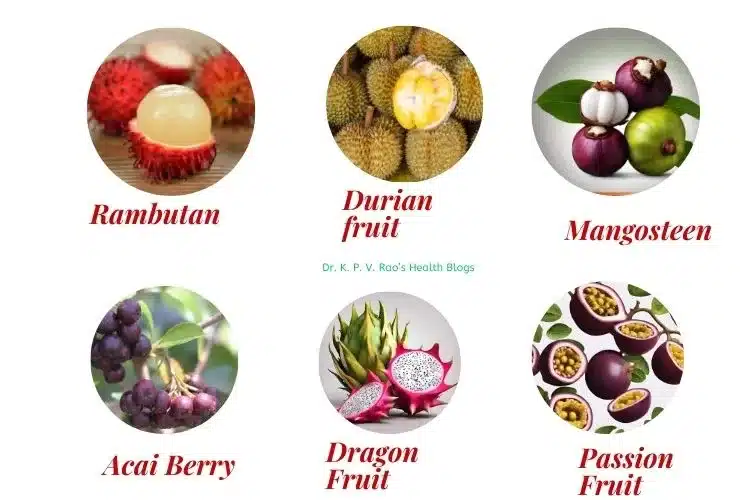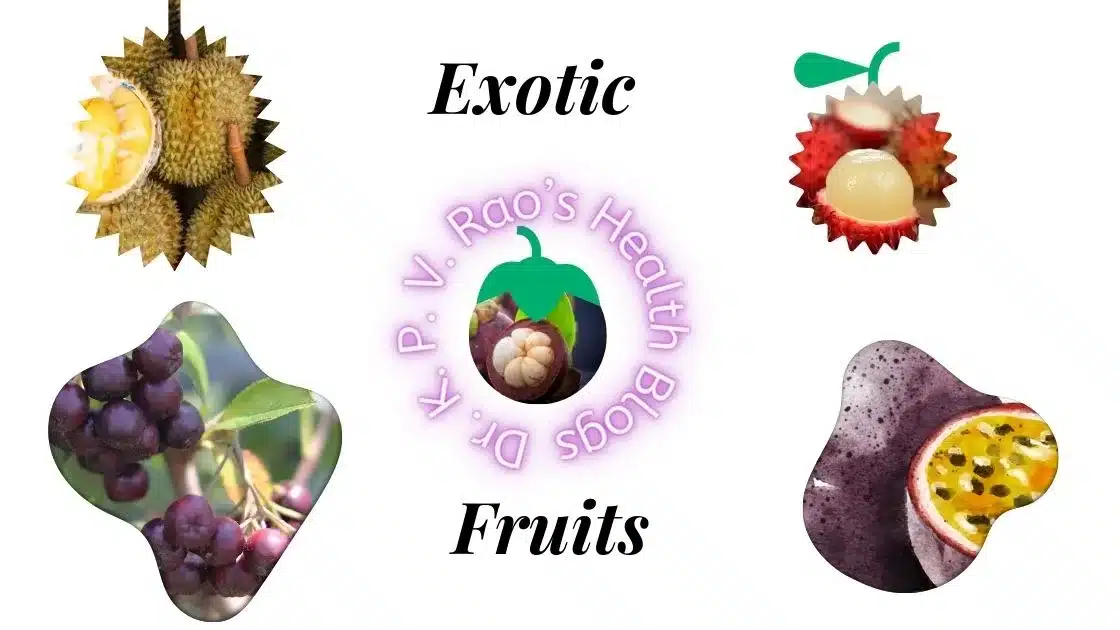Exploring Exotic Fruits: Unveiling the Nutritional Powerhouses from Around the World
Introduction
In the past, I have written about fruits that are locally available all over the world. I hope you have read my recent blog on 5 colorful fruits to be eaten and relished for good health.
There are seven continents on earth. In this article we will discuss some exotic fruits that are native to five continents, namely Asia, Africa, North America, South America, and Australia.
As this article is quite vast, I have split it into two. In Part 1, we will cover fruits that are native to Asia and South America. In Part 2, we will cover fruits from Europe, North America and Australia.
The idea or purpose behind writing this article on exotic fruits is to educate and spread awareness to the readers about these fruits, where they are usually found, benefits of consuming them, thereby improving health and reducing or doing away with medicines in some diseases.
So, what are exotic fruits?
Exotic fruits are a diverse category of fruits that originate from regions across the globe and are not commonly found in everyday markets.
These fruits stand out due to their unique flavors, vibrant colors, and distinctive appearances.
Rich in vitamins, minerals, and antioxidants, exotic fruits offer a variety of health benefits and can be a nutritious addition to any diet.
From the tropical sweetness of mangosteen to the tartness of dragon fruit, exploring exotic fruits opens up a world of enticing flavors and nutritional powerhouses.
Why should you explore them?
Exotic fruits offer unique flavors and nutritional benefits that can enhance your diet. They provide a wide range of vitamins, minerals, antioxidants, and fiber, which are essential for maintaining good health.
Additionally, exploring exotic fruits can introduce variety into your diet and help you discover new flavors and culinary experiences.
What are the top exotic fruits?
Today, in this article we will be learning about these top exotic fruits as mentioned and shown below: –
- Dragon fruit,
- Durian,
- Mangosteen
- Passion fruit,
- Acai berry.
- Persimmon
- Rambutan

Exotic Fruits from Asia
– Durian: The King of Fruits
The Durian fruit from Asia is considered the king of fruits due to its distinctive characteristics and strong flavor. It has a unique combination of sweet, creamy, and slightly savory taste that many people find enjoyable.
The fruit is also known for its strong odor, which is often described as pungent and even repulsive by some individuals.
Despite its smell, the Durian is highly sought after and appreciated for its rich and indulgent flavor.
Suggested read- Durian- the King of Fruits
Dragon Fruit: A Vibrant Tropical Delight
Dragon fruit is a tropical fruit known for its vibrant appearance and is often called a tropical delight.
It is rich in antioxidants, vitamins, and minerals, which contribute to its potential health benefits.
These benefits may include improved digestion, boosted immune system, reduced risk of chronic diseases, and enhanced skin health.
Some people suggest dragon fruit to be given for dengue fever.
Mangosteen: The Queen of Fruits
The mangosteen fruit is a tropical fruit known for its sweet and tangy flavor. It is rich in nutrients such as vitamin C, fiber, and antioxidants.
Some potential health benefits of mangosteen include promoting immune function, supporting digestion, and reducing inflammation.
Mangosteen is primarily grown in Southeast Asia but is also available in some parts of the United States through specialty stores and online platforms.
Rambutan
Rambutan is a tropical fruit that is native to Southeast Asia and some parts of North America.
In 100 grams of the pulp of rambutan fruit, you can find approximately:
- 68 calories
- 16.5 grams of carbohydrates,
- 0.9 grams of protein, and 0.9 grams of fat
- It is also a good source of vitamin C, providing around 20.9 milligrams per 100 grams. Additionally, it contains small amounts of iron, calcium, and phosphorus.
When it comes to health benefits, rambutan is known to have antioxidant properties, which can help fight against free radicals in the body.
It also contains fiber, which aids in digestion and promotes a healthy digestive system.
Rambutan is a hydrating fruit that can help keep you refreshed and hydrated. However, it’s important to note that individual nutritional needs may vary, so it’s advisable to consult a healthcare professional for personalized advice.
Exotic Fruits from South America and North America
Acai Berry: The Superfood Sensation
Acai berry is a superfood sensation known for its rich nutrient content. It primarily grows in the Amazon rainforest of Brazil.
Acai berries can be exported to various parts of the world. In 100 grams of fruit, you can find approximately
- 80-250 calories,
- 4 grams of protein,
- 8 grams of fat, and
- 15 grams of carbohydrates.
Additionally, acai berries are a good source of fiber, vitamin A, calcium, and antioxidants.
Pitaya (Dragon Fruit): Exotic and Nutrient-Rich
Pitaya fruit, also known as dragon fruit, is primarily grown in tropical and subtropical regions.
In terms of nutritional facts, 100 grams of pitaya fruit typically contains approximately
- 60-80 calories,
- 9-14 grams of carbohydrates,
- 1-2 grams of fiber, and
- around 1 gram of protein
- vitamin C, providing about 20-30% of the recommended daily intake.
Regarding export, pitaya fruit can be exported to various countries, subject to specific regulations and requirements.
Maracuja (Passion Fruit): Sweet and Tangy Goodness
Maracuja fruit, also known as passion fruit, is generally found in tropical and subtropical regions. Here are the nutritional facts of maracuja fruit per 100 grams:
- Calories: 97
- Carbohydrates: 23 grams
- Fiber: 10 grams
- Protein: 2 grams
- Fat: 0.7 grams
- Vitamin C: 30% of the daily recommended intake
- Vitamin A: 25% of the daily recommended intake
- Iron: 20% of the daily recommended intake
Some health benefits of maracuja fruit include improved digestion, boosted immune system, reduced inflammation, and enhanced skin health.

Physalis: The Golden Berry
Physalis, commonly known as the golden berry, is generally found in South America.
In terms of nutritional facts, 100 grams of the fruit contains approximately:
- 53 calories,
- 11 grams of carbohydrates,
- 2 grams of protein, and 1 gram of fat
- Golden berries are also rich in vitamins A, C, and K, as well as various antioxidants.
Some potential health benefits of consuming golden berries include improved digestion, strengthened immune system, and reduced inflammation.
Persimmon
Persimmons are some fruits primarily found in Asia and North America. It is rich in nutrients and provides several health benefits.
In 100 grams of persimmon, you can expect to find approximately:
- Energy: 81 calories
- Carbohydrates: 18 grams
- Fiber: 3.6 grams
- Protein: 0.6 grams
- Fat: 0.2 grams
- Vitamin A: 81 micrograms
- Vitamin C: 7.5 milligrams
- Vitamin E: 0.73 milligrams
- Vitamin K: 2.6 micrograms
- Potassium: 161 milligrams
- Manganese: 0.161 milligrams
Some potential health benefits of persimmon include supporting heart health, aiding digestion, boosting immune function, and providing antioxidant properties that improve health in chronic diseases like arthritis.
Suggested Listening– You can also listen to a podcast on mangosteen and passion fruit by clicking this link to Produce Buzzers:
To be concluded
So far, we have explored fruits from two continents. In my next article, we will explore exotic fruits from the remaining three continents as mentioned above.
Till then- Adios.

